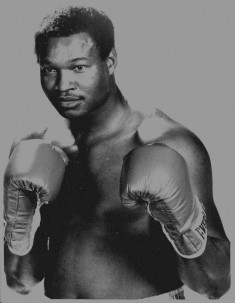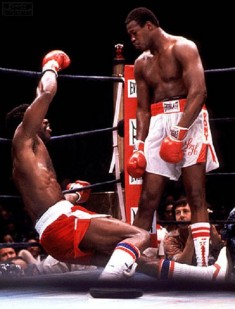| Larry Holmes | |
|---|---|
 |
|
| Boxer | |
| Born | Nov. 3, 1949 Cuthbert, Georgia, USA |
| Nationality | American |
Larry Holmes (born 1949) is a retired American professional boxer. He was nicknamed the Easton Assassin after the area of Pennsylvania where he was raised. Holmes was a world heavyweight champion several times with different organizations, although he never unified the belts.
Only Joe Louis made more winning title defenses than Holmes’ 20. His record was exceptional: he did not fail to win until his 49th professional bout. He retired in 1985, but he made several comebacks, eventually fighting into his early fifties. He is a member of the World and International Boxing Halls of Fame.
Early Life
Holmes was born in the small Georgia town of Cuthbert on November 3, 1949. He was the fourth of 12 children, but his parents separated when he was only seven years old. Along with his brothers and sisters, he went with his mother to Pennsylvania and the family settled in Easton.
The family was poor and as a result, Holmes was unable to complete his schooling. When he was 13, he had to quit school so he could go earn a dollar an hour working for a car wash in the area. Over the next few years, he drifted from job to job: he was a steel pourer, dump truck driver, and even a sandblaster at various times. He usually gave the money he earned to his mother because she was reliant on welfare to feed her large family.
The Attitude of a Boxer
Despite Holmes’ generosity to his family, he was a much tougher character to many others. He was already confident of his fighting abilities, frequently ending up in brawls if he felt that a person had been disrespectful. He cultivated a tough-guy image and later claimed that “every weekend” he had knocked out a challenger of some kind.
His raw abilities became legendary in his neighborhood as he often went dozens of street fights without being defeated. On one occasion, he even produced a streak of 40 wins. By the time he was 19, he weighed 200 pounds and was 6 feet 3 inches tall. He was now sure that he could make a success of a professional boxing career.
Becoming a Professional Boxer
Holmes went to see Earnee Butler to ask him to be his coach. Butler was a local businessman in Easton, but he had once appeared in a professional boxing match. He helped Holmes refine his talents into something more suitable for a regulated sport, and the young man’s 22 fights in the amateur ranks brought him 19 wins.
However, by the spring of 1973, he knew that it was time for him to turn professional. For the time being, he kept on working with Butler, but he eventually became frustrated and felt that he had gone as far as he could with his original manager. After breaking off his partnership with Butler, Holmes was managed by several different people, ranging from near-unknowns to the likes of Don King.
Holmes’ Big Break
 Although Holmes was quite successful in his professional career, he was largely ignored by the really big names as well as by many sports reporters and boxing fans. In fact, he earned considerably more by acting as a sparring partner for first-rankers. In this role, Holmes shared a ring with the likes of Earnie Shavers, Joe Frazier, and even Muhammad Ali.
Although Holmes was quite successful in his professional career, he was largely ignored by the really big names as well as by many sports reporters and boxing fans. In fact, he earned considerably more by acting as a sparring partner for first-rankers. In this role, Holmes shared a ring with the likes of Earnie Shavers, Joe Frazier, and even Muhammad Ali.
In March of 1978, however, Holmes got his big chance with a fight against Shavers. His victory allowed him to set up a September bout with Ken Norton for the WBC championship of the world. This match went down as a classic, with Holmes wearing down the winner after an exhausting 15-round spectacle.
Life as a Champion
Holmes continued to enjoy success in the ring for the following five years, holding on to his WBC (World Boxing Council) title until 1983. In that year, he decided to drop his claim to the belt in order to be installed as the IBF (International Boxing Federation) champion. The IBF, which had only just been formed, saw Holmes defend its belt on three occasions, after the last of which his pro record stood at a remarkable 48-0.
Only Rocky Marciano, with a 49-0 record, had done better – but Holmes’ attempt to match the great Marciano was to fail. In September of 1985, he was surprisingly beaten on points by Michael Spinks, with a rematch after six months producing the same result. Holmes, embittered and embarrassed, decided to retire.
Retirement and Life after Boxing
In 1988, Holmes returned to boxing, losing to the undisputed heavyweight champion Mike Tyson in a fourth-round knockout. Holmes retired once more afterward, but in 1991, he made a slightly longer comeback, gaining several victories before pulling off a startling win over Ray Mercer. In 1992, he was able to challenge Evander Holyfield, who was by now the heavyweight champion, but Holmes lost in 12 rounds.
Holmes had yet another title shot in 1995, losing only narrowly to WBC champion Oliver McCall. He finally retired for good in 2002, when at the age of 52 he stopped Eric “Butterbean” Esch in 10 rounds. He then became a businessman with a range of interests, including opening two restaurants.